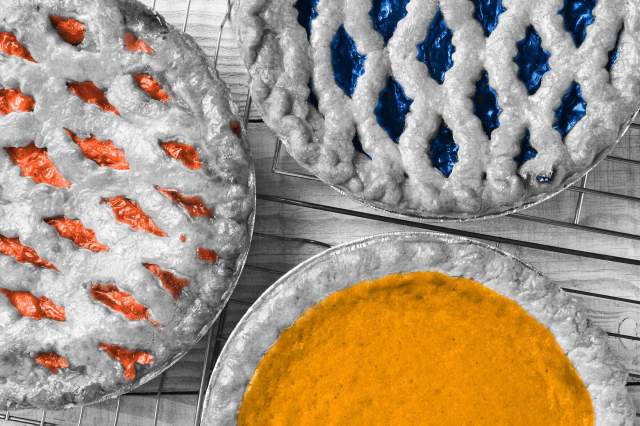
Mincemeat Pie: Cuisine From the Crusades
In the 13th century, European crusaders returned home with stories of war — and, if legends are true, a few good pie recipes inspired by Middle Eastern cuisine, which fearlessly combined sweet and savory flavors. Clearly impressed, the crusaders told those back home about delicacies containing an array of meats, fruits, and spices available only in distant lands. (A 1390 recipe for “tartes of flesh,” for example, suggests adding saffron to a pastry of sugar, pork, cheese, and eggs.) Expensive to bake, the pie recipes influenced by the crusaders were initially reserved for the wealthy or presented at feasts and holidays. By the 16th century, though, these “mincemeat” treats were a Christmastime mainstay. Today’s mincemeat pies are actually just mince pies; meat was dropped from the recipe sometime before the Victorian era.

Blueberry Pie: A Wartime Treat
Berry and drupe-based pies have existed since the 16th century, when Queen Elizabeth I famously took a bite of the world’s first cherry pie. But when pies came to the New World, non-native fruits took precedence over blueberries. That changed during the Civil War. As brother fought brother, sardine canneries in New England lost most of their business in the Deep South. Thankfully, Maine was (and is) the largest producer of wild blueberries in the world, so the factories pivoted to canning local fruits instead. Soon, the struggling canneries captured a new market: Soldiers who had never tasted Maine blueberries were downing the stuff by the dozens, transporting them in the form of pies. An American classic was born.

Apple Pie: Britain’s Gift to America
The phrase “as American as apple pie” is a misnomer: The dish is decidedly British. Unlike blueberries, apple trees are not native to North America. (Rather, America’s first apple seeds and cuttings were brought over by Jamestown colonists for the purpose of making cider.) Britain’s first apple pie recipe was recorded back in 1381 by Canterbury Tales author Geoffrey Chaucer, who called for figs, berries, saffron, and more. Here it is:
Tak gode Applys and gode Spyeis and Figys and Reysons and Perys and wan they re wel ybrayed colourd wyth Safron wel and do yt in a cosyn and do yt forth to bake wel.
As with blueberry pie, America’s love affair with apple pie may be traced back to the United States military. By the early 20th century, America had become one of the world’s largest apple producers. During World War II, it was common for soldiers abroad to say they were fighting “for mom and apple pie.”
More Interesting Reads

Pumpkin Pie: Star of America’s First Cookbook
When you think of it, it’s odd to transform a gourd into a sweet dessert. But Americans have been doing it since the mid-17th century. In 1655 in New Netherland — now New York state — a Dutch lawyer named Adriaen van der Donck observed that “the English, who are fond of tasty food, like pumpkins very much and use them also in pies.” These early pastries, however, did not resemble modern pumpkin pies. “They contained layers of sliced (sometimes fried) pumpkin, combined with sugar, spices, and apple slices,” Ellen Terrell writes for the Library of Congress blog. The first modern custard-style pumpkin pie recipe wouldn’t be recorded until 141 years later, when Amelia Simmons wrote the first American cookbook. (You can view the recipe here.)

Key Lime Pie: The Pride of Florida
Floridians are defensive about their state pie — and for good reason. Key limes, with their uniquely pleasant pucker, are named for their association with the Florida Keys, where they first thrived in the United States. But the pie itself may not be a Sunshine State creation. According to some sources, the dairy-loving masterminds at the Borden Company concocted the recipe that would become key lime pie in a New York City test kitchen in 1931. (The recipe was a ploy to sell sweetened condensed milk.) Floridians, however, still insist that the original key lime pie was invented by a cook with the mysterious name of “Aunt Sally,” who allegedly adapted the recipe after acquiring it from a sponge fisherman working off the Florida Keys.











